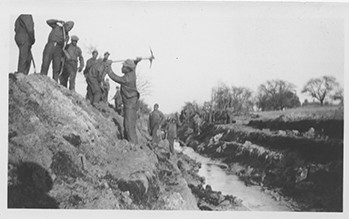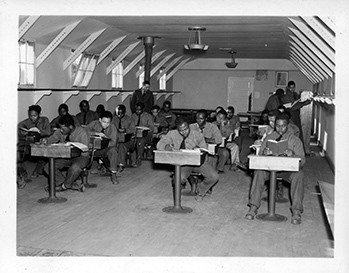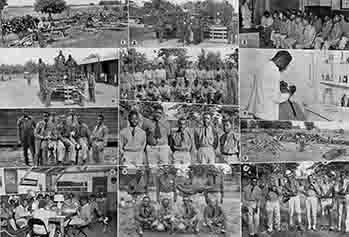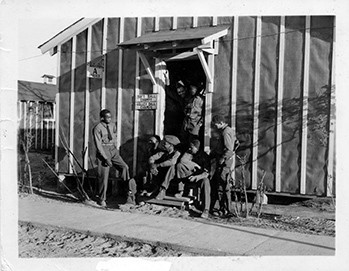Showcasing the DNR: Highlighting diversity in the ranks of the Civilian Conservation Corps
Editor’s note: In celebration of the department’s centennial anniversary, the Showcasing the DNR feature series will highlight one story each month during 2021 that recalls various historical events over the past century.
By HILLARY PINE
Michigan Department of Natural Resources
In the early 1930s, the nation was grappling with the Great Depression.
Michigan, like the rest of the nation, was facing record-high unemployment rates. In Detroit, for example, African American unemployment rates reached 60%. Michiganders were struggling to find jobs and were going hungry.
To help with the crisis, President Franklin Delano Roosevelt implemented the Emergency Conservation Work program just a few weeks after taking office in March 1933. The program came to be known as the Civilian Conservation Corps.
“The CCC was established to provide employment, as well as vocational training, for youthful citizens of the United States who were unemployed and in need of employment and, to a limited extent, for war veterans and Indians, through the performance of useful public work in connection with the conservation and development of the natural resources of the United States, its territories, and insular possessions,” according to the National Archives website.

“In May 1940, the corps began gradually converting to defense work on military reservations and forest protection. The Labor-Federal Security Appropriation Act of 1943, approved July 2, 1942, provided for the liquidation of the CCC not later than June 30, 1943.”
Roosevelt saw that states like Michigan needed reforestation and fire protection. In addition, Americans were visiting state and national parks in record-high numbers. The parks did not have trails or facilities to support that many visitors.
The CCC was the solution to both the unemployment of American men and the critical conservation needs on state and federal lands.
By the end of May 1933, Michigan had 12 CCC camps, and the Michigan Department of Conservation (predecessor of the Michigan Department of Natural Resources) had an army of young men at its disposal. CCC enrollees lived in camps operated by the War Department. They earned $30 per month for their work, of which $25 went directly to their families.
Michael Rataj, an enrollee at Camp Mackinac, remembered receiving a letter from his family explaining that they were able to purchase a coat, food and wood for the stove.
|

Rataj said that “you felt for the first time that you were helping your family, and nothing could induce you to leave the CCC.”
Though unemployment rates for African Americans and Native Americans were above the national average, the program favored white enrollees. It capped African American enrollment at 10% of the total.
While the program began as an integrated organization, pervasive structural racism made integrated camps incompatible with the realities of camp life.
In 1935, the federal government segregated CCC camps. By the time the CCC ended, Michigan had one Native American camp, operated by the Bureau of Indian Affairs, and 11 African American camps.
Michigan’s Native American camp was Camp Marquette, located in Chippewa County in the Upper Peninsula. Michigan’s 11 African American camps were all located in the northern Lower Peninsula. They were camps Axin, Baldwin, Bitely, Custer, Harrietta, Houghton Lake, Mack Lake, Stronach, Walkerville, White River and Wolf Lake.
While black enrollees served in integrated camps in the Upper Peninsula at the start of the program, all the African American camps were moved to the Lower Peninsula.
|

“There were very few African Americans in the area. We were a rarity and therefore often under suspicion of misconduct,” recalled Reverend William Elum, an early Black enrollee who served in the Upper Peninsula. “If [the police] saw you walking, they’d arrest you even if you did not do anything wrong.”
In the mid-1930s, CCC program administrators scrapped plans to open an African American camp in Chippewa County.
For the most part, enrollees were new to rural life and heavy physical labor. Fighting fires, planting trees and restoring streams in icy cold waters were just a few of the difficult tasks the CCC boys accomplished.
George Yannett, an Odawa from the Grand Traverse Band of Chippewa and Ottawa Indians, admitted that “I never thought I could get hurt. [But] there I was with a spade and a hoe, in the middle of a blaze!”
Beyond conservation, the CCC aimed to educate enrollees and provide them with life-long skills so they could find work when they left the program. After 1934, each CCC camp was assigned an education advisor and educational opportunities were expanded and heavily promoted in the camps.
By June 1940, the CCC granted 900 eighth-grade diplomas in Michigan. The camps also provided high school classes, and some enrollees took college correspondence courses offered in conjunction with the University of Michigan.
|

Many enrollees also took advantage of trade and vocational skills classes offered through the camps. Examples of these classes included surveying, auto mechanics and typing.
By the time the CCC ended in 1942, 3 million people had been enrolled in the CCC. Of that total, only 200,000 were African American. In Michigan, more than 100,000 men had participated in the program.
Not only were they now prepared for life outside of the CCC, whether that be in the Army or in a trade, but they had transformed the landscape of Michigan in ways that can still be seen today.
If you have noticed trees growing in perfectly straight lines along Michigan roadways in the northern Lower and Upper peninsulas, those may be some of the 484 million trees the CCC planted. If you have used state park trails, campgrounds or bathrooms, then you most likely enjoyed the work of the CCC.
Nicknamed Roosevelt’s Tree Army, the Civilian Conservation Corps program had wide-ranging benefits for Michigan’s economy, landscape and enrollees.
The lush forests, extensive Michigan truck trail and firebreak system, Isle Royale National Park, the Seney National Wildlife Refuge, countless state parks and miles upon miles of fertile rivers are all thanks to the hard work of CCC enrollees.
|

The pride “CCC boys” – as they called themselves – had for their work was evidenced in the lobbying for and construction of the Michigan Civilian Conservation Corps Museum in the northern Lower Peninsula in Roscommon County.
CCC boys helped erect this monument to their legacy, built in 1985 on the site of the Higgins Lake Nursery. The museum, which was recently refurbished, is open for visitors from Memorial Day to Labor Day.
The grounds of the Higgins Lake Nursery and CCC Museum at North Higgins Lake State Park in Roscommon are open year-round.
Learn more about the profound impact reforestation and the CCC had on Michigan at Michigan.gov/HigginsLakeCCC.
|
Check out previous Showcasing the DNR stories in our archive at Michigan.gov/DNRStories. To subscribe to upcoming Showcasing articles, sign up for free email delivery at Michigan.gov/DNR.
/Note to editors: Contact: John Pepin, Showcasing the DNR series editor, 906-226-1352. Accompanying photos and a text-only version of this story are available below for download. Caption information follows. Credit Michigan Department of Natural Resources, unless otherwise noted.
Text-only version - Showcasing - CCC diversity
Axin: A collage of images shows the daily activities of the 2693rd Civilian Conservaton Corps Company of Camp Axin, located in Cadillac.
Barracks: Civilian Conservation Corps enrollees from Barracks A at Camp Bitely made the most of their leisure time, as the signs announcing their softball and volleyball championships attest.
Classroom: Enrollees at Camp Bitely study for their diplomas as part of their Civilian Conservation Corps service.
Diplomas: Fifty-five Civilian Conservation Corps enrollees from Michigan’s Fort Custer district, which included several Lower Peninsula camps, pose with their eighth-grade diplomas.
Hartwick: The Civilian Conservation Corps camp at Hartwick Pines was originally integrated, as this photograph of the camp personnel shows.
Hartwick-Wide: A black and white panoramic image from Hartwick Pines shows uniformed Civilian Conservation Corps camp personnel posed in five rows, with several barracks in the background.
Restoration: In addition to fighting forest fires, the men of Michigan’s Civilian Conservation Corps camps worked on conservation and restoration projects. In this photo, enrollees work to restore a stream./
|